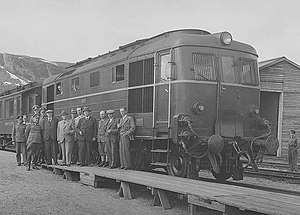NSB Di 1
| NSB Di 1 |

NSB Di 1 no. 601 in 1942
|
|
|
| Specifications |
Configuration:
|
|
| • UIC
|
1'BB'1 |
| Length |
13.5 m (44 ft 3 in) |
| Loco weight |
82.7 t (81.4 long tons; 91.2 short tons) |
|
| Performance figures |
| Maximum speed |
100 km/h (62 mph) |
| Power output |
1,472 kW (1,974 hp) |
|
| Career |
| Operators |
Norwegian State Railways |
| Number in class |
1 |
| Numbers |
1 601 |
| First run |
1942 |
| Withdrawn |
1959 |
| Disposition |
Scrapped |
|
| Specifications |
Configuration:
|
|
| • UIC
|
1'BB'1 |
| Length |
13.5 m (44 ft 3 in) |
| Loco weight |
82.7 t (81.4 long tons; 91.2 short tons) |
| Performance figures |
| Maximum speed |
100 km/h (62 mph) |
| Power output |
1,472 kW (1,974 hp) |
| Career |
| Operators |
Norwegian State Railways |
| Number in class |
1 |
| Numbers |
1 601 |
| First run |
1942 |
| Withdrawn |
1959 |
| Disposition |
Scrapped |
NSB Di 1 was a class of diesel-hydraulic locomotives built by Krupp for the Norwegian State Railways (NSB). The locomotive had two MAN diesel engines, giving a combined power output of 1,472 kilowatts (1,974 hp) and allowing the 82.7 tonnes (81.4 long tons; 91.2 short tons) vehicle to reach a maximum speed of 100 km/h (62 mph). It had a 1'BB'1 wheel arrangement and a driver's cab at only one end.
Two units were ordered in 1937, but only one locomotive was delivered, in 1942. Numbered 601, it was the first diesel locomotive used by NSB. As first serving on the Bergen Line, although the locomotive was plagued with technical faults causing it to be out of service for shorter and longer periods. The locomotive was moved to the Dovre Line from 1952 and finally to the Gjøvik Line and Kongsvinger Line from 1957. The locomotive was retired and scrapped in 1959.
The Di 1 was the first class of diesel locomotives ordered by the Norwegian State Railways. Krupp had developed the diesel-hydraulic transmission system during the early 1930s, which at the time proved superior to the diesel-electric transmission system. NSB ordered two locomotives in 1937 to test out the new technology. However, the deliveries were delayed and in the end only one locomotive was delivered, in 1942. The locomotive was designed to be operated in pairs, and thus only received a cab at one end. As only one unit was delivered, the locomotive was in need of turntables to operate. The locomotive was numbered 601, allowing for ample additional steam locomotives to be delivered in the remaining, lower-numbered slots.
The locomotive was initially used on the Bergen Line. The advanced designed, combined with lack of suitable competence among NSB's staff and lack of spare parts, resulted in the locomotive seeing little revenue use. After a few years it was taken out of service and did not re-enter use until 1947, when the diesel shortage had diminished. A contributing factor was also the poor workmanship caused by the wartime industry. The locomotive was transferred from Oslo to Bergen District on 20 December 1945 and was used on the Bergen Line. During 1952 the locomotive started being used on the Dovre Line, and it was official transferred to Trondheim District on 20 October.
...
Wikipedia

